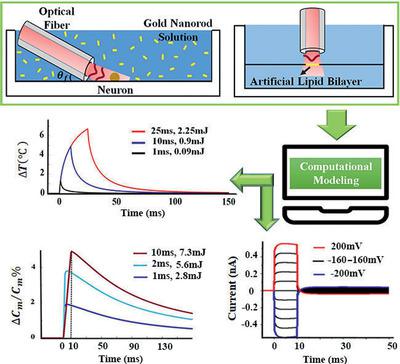当前位置:
X-MOL 学术
›
Adv. Theory Simul.
›
论文详情
Our official English website, www.x-mol.net, welcomes your
feedback! (Note: you will need to create a separate account there.)
Direct and Plasmonic Nanoparticle‐Mediated Infrared Neural Stimulation: Comprehensive Computational Modeling and Validation
Advanced Theory and Simulations ( IF 2.9 ) Pub Date : 2021-03-26 , DOI: 10.1002/adts.202000214 Zahra Ebtehaj 1 , Mohammad Malekmohammad 1 , Ali Hatef 2 , Mahmood Soltanolkotabi 1
Advanced Theory and Simulations ( IF 2.9 ) Pub Date : 2021-03-26 , DOI: 10.1002/adts.202000214 Zahra Ebtehaj 1 , Mohammad Malekmohammad 1 , Ali Hatef 2 , Mahmood Soltanolkotabi 1
Affiliation

|
Infrared neural stimulation techniques have potential applications in the diagnosis and treatment of numerous neurological and psychiatric disorders. There has been little progress in the computational modeling of these techniques and further improvement is needed in this area. In this paper, a comprehensive computational model is presented for simulating the complete mechanism of direct and plasmonic nanoparticle‐mediated infrared neural stimulation techniques in schematic samples of experimental setups. The simulation process involves three phases: 1) Simulating the light transmission and absorption in setups containing pure water or a gold nanorod solution using developed 3D, time‐independent, and time‐dependent Monte Carlo models, 2) calculating the spatiotemporal evolutions of temperature within the setup using the finite difference method and a presented novel method, and 3) simulating the thermally induced responses of lipid membranes using an improved method compared to existing theoretical models. The model is validated by comparing the computational results with existing experimental data. The effect of the laser pulse characteristics, nanofluid properties, and some other related parameters on the thermally induced membrane responses is investigated. The computational results help to optimize the parameters selection and maximize the overall efficiency of the infrared neural stimulation techniques.
中文翻译:

直接和等离子体纳米粒子介导的红外神经刺激:全面的计算建模和验证
红外神经刺激技术在许多神经和精神疾病的诊断和治疗中具有潜在的应用。这些技术的计算建模几乎没有进展,在这一领域还需要进一步的改进。本文提出了一个综合的计算模型,用于在实验装置的示意图样本中模拟直接和等离子体纳米粒子介导的红外神经刺激技术的完整机制。仿真过程包括三个阶段:1)使用开发的3D,时间独立和时间依赖的蒙特卡洛模型,在包含纯水或金纳米棒溶液的设置中模拟光的传输和吸收,2)使用有限差分法和提出的新颖方法计算设置内温度的时空演变,以及3)与现有理论模型相比,使用改进方法模拟脂质膜的热诱导响应。通过将计算结果与现有实验数据进行比较来验证该模型。研究了激光脉冲特性,纳米流体特性以及其他一些相关参数对热诱导膜响应的影响。计算结果有助于优化参数选择并最大化红外神经刺激技术的整体效率。通过将计算结果与现有实验数据进行比较来验证该模型。研究了激光脉冲特性,纳米流体特性以及其他一些相关参数对热诱导膜响应的影响。计算结果有助于优化参数选择并最大化红外神经刺激技术的整体效率。通过将计算结果与现有实验数据进行比较来验证该模型。研究了激光脉冲特性,纳米流体特性以及其他一些相关参数对热诱导膜响应的影响。计算结果有助于优化参数选择并最大化红外神经刺激技术的整体效率。
更新日期:2021-05-05
中文翻译:

直接和等离子体纳米粒子介导的红外神经刺激:全面的计算建模和验证
红外神经刺激技术在许多神经和精神疾病的诊断和治疗中具有潜在的应用。这些技术的计算建模几乎没有进展,在这一领域还需要进一步的改进。本文提出了一个综合的计算模型,用于在实验装置的示意图样本中模拟直接和等离子体纳米粒子介导的红外神经刺激技术的完整机制。仿真过程包括三个阶段:1)使用开发的3D,时间独立和时间依赖的蒙特卡洛模型,在包含纯水或金纳米棒溶液的设置中模拟光的传输和吸收,2)使用有限差分法和提出的新颖方法计算设置内温度的时空演变,以及3)与现有理论模型相比,使用改进方法模拟脂质膜的热诱导响应。通过将计算结果与现有实验数据进行比较来验证该模型。研究了激光脉冲特性,纳米流体特性以及其他一些相关参数对热诱导膜响应的影响。计算结果有助于优化参数选择并最大化红外神经刺激技术的整体效率。通过将计算结果与现有实验数据进行比较来验证该模型。研究了激光脉冲特性,纳米流体特性以及其他一些相关参数对热诱导膜响应的影响。计算结果有助于优化参数选择并最大化红外神经刺激技术的整体效率。通过将计算结果与现有实验数据进行比较来验证该模型。研究了激光脉冲特性,纳米流体特性以及其他一些相关参数对热诱导膜响应的影响。计算结果有助于优化参数选择并最大化红外神经刺激技术的整体效率。











































 京公网安备 11010802027423号
京公网安备 11010802027423号